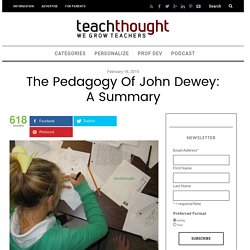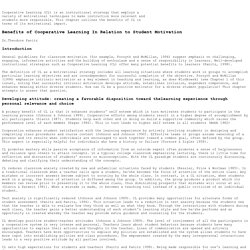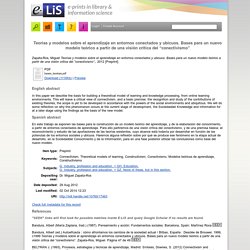

Monografico-Aprendizaje-Basado-en-Problemas.pdf. The Pedagogy Of John Dewey: A Summary. The Pedagogy Of John Dewey: A Summary by Steve Wheeler, Associate Professor, Plymouth Institute of Education This is number 7 in my blog series on major learning theories.

My plan is to work through the alphabet of psychologists and provide a brief overview of their theories, and how each can be applied in education. In the last post we examined the work of Mihály Csíkszentmihályi on Flow Theory. In this post, we explore the work of John Dewey on experiential and interactive learning. John Dewey is one of the giants in the history of educational theory, and it’s difficult to isolate one of his specific theories to discuss here.
The theory and how it can be applied to education Even before the constructivist theories of Jean Piaget and Lev Vygotsky were widely known, Dewey was talking about how children learn best when they interacted with their environments and were actively involved with the school curriculum. Reference Dewey, J. (2011) Democracy and Education. Constructivism as a Paradigm for Teaching and Learning. What is constructivism?

How does this theory differ from traditional ideas about teaching and learning? What does constructivism have to do with my classroom? Expert Interview What is the history of constructivism, and how has it changed over time? What are some critical perspectives? What are the benefits of constructivism? What does constructivism have to do with my classroom? As is the case with many of the current/popular paradigms, you're probably already using the constructivist approach to some degree. Prompt students to formulate their own questions (inquiry) allow multiple interpretations and expressions of learning (multiple intelligences) encourage group work and the use of peers as resources (collaborative learning) More information on the above processes is covered in other workshops in this series.
In a constructivist classroom, learning is . . . Students are not blank slates upon which knowledge is etched. The student is the person who creates new understanding for him/herself. Project-Based Learning. Why Teach with Project-Based Learning?: Providing Students With a Well-Rounded Classroom Experience. Because project-based learning is filled with active and engaged learning, it inspires students to obtain a deeper knowledge of the subjects they're studying.

Research also indicates that students are more likely to retain the knowledge gained through this approach far more readily than through traditional textbook-centered learning. In addition, students develop confidence and self-direction as they move through both team-based and independent work. In the process of completing their projects, students also hone their organizational and research skills, develop better communication with their peers and adults, and often work within their community while seeing the positive effect of their work. Because students are evaluated on the basis of their projects, rather than on the comparatively narrow rubrics defined by exams, essays, and written reports, assessment of project-based work is often more meaningful to them. Students also thrive on the greater flexibility of project learning. An Introduction to Project-Based Learning. How cl motivates students and teachers. Cooperative Learning (CL) is an instructional strategy that employs avariety of motivational techniques to make instruction more relevant andstudents more responsible.

This chapter outlines the benefits of CL interms of its motivational impact. Benefits of Cooperative Learning In Relation to Student Motivation Dr.Theodore Panitz Introduction General guidelines for classroom motivation (for example, Forsyth and McMillan, 1994) suggest emphasis on challenging, engaging, informative activities and the building of enthusiasm and a sense of responsibility in learners. The definition of CL as a motivational strategy includes all learning situations where students work in groups to accomplish particular learning objectives and are interdependent for successful completion of the objective.
Developing attitude: creating a favorable disposition toward thelearning experience through personal relevance and choice Test anxiety is significantly reduced (Johnson and Johnson 1989). Conclusion Astin, A.W. EA.Piaget%20_%20Papert.pdf. Lerenlerennu/bronnen/Learning styles by Coffield e.a..pdf. Learning Theories, Learning Models, Learning Theory Summaries - in Plain English! Teorías y modelos sobre el aprendizaje en entornos conectados y ubicuos. Bases para un nuevo modelo teórico a partir de una visión critica del “conectivismo” Zapata-Ros, Miguel Teorías y modelos sobre el aprendizaje en entornos conectados y ubicuos.

Bases para un nuevo modelo teórico a partir de una visión critica del “conectivismo”., 2012 [Preprint] English abstract In this paper we describe the basis for building a theoretical model of learning and knowledge processing, from online learning environments. This will leave a critical view of connectivism, and a basic premise: the recognition and study of the contributions of existing theories, the scope is yet to be developed in accordance with the powers of the social environments and ubiquitous. We will do some reflection on why this phenomenon occurs at the current stage of development, the Sociedaddel Knowledge and Information for at a later stage using the findings as the basis of the new model. Spanish abstract References "SEEK" links will first look for possible matches inside E-LIS and query Google Scholar if no results are found.